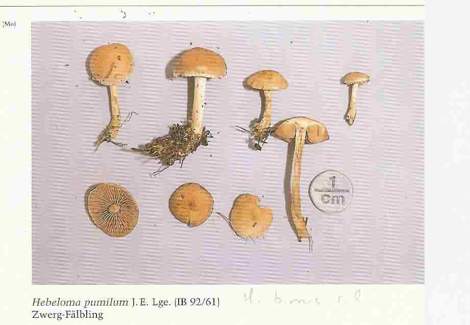 Hebeloma melleum (Photo: M. Moser)
Hebeloma melleum (Photo: M. Moser)Taxonomy
Full name: Hebeloma melleum Beker & U. Eberh., Hebeloma (Fr.) P. Kumm.: 461 (2016)Genus: Hebeloma
Section: Scabrispora
Types: AUSTRIA: Maria Waldrast,Tirol, Matrei, Maria Waldrast (approx. 47.13°N, 11.4°E, alt. approx. 1750 m a.s.l.) in subalpine woodland under Larix sp. and Picea sp., 18 Jul. 1992, M. Moser (Holotype. herbarium acc. no. IB19920061, HJB11592).
- arrow_drop_downarrow_drop_upEtymologyFrom melleus– honey, to emphasise the colour of the basidiomes.
- arrow_drop_downarrow_drop_upDiagnosisHebeloma melleum lacks an annulus, has a weakly rooting stipe and cystidia, which are mainly cylindrical. This, as well as molecular data, places the species in H. sect. Scabrispora. Molecular data (ITS, mitSSU V6 and V9) all support that the only available collection of H. melleum represents an independent species and does not belong to any of the other recognised European species. Hebeloma melleum is similar to H. pumilum, but it differs by its more honey, saffron yellow pileus colours and its slightly longer spores.
References
Description
- arrow_drop_downarrow_drop_upThresholds
Description of Hebeloma melleum based on 3 collections
- arrow_drop_downarrow_drop_upMacroscopic descriptionPileus: (11) 13 (16) mm diameter; shape convex or broadly umbonate; characters spotting; margin characters crenulate; viscosity tacky when moist; colour variation unicolour; colour at centre often honey or ochraceous.
Lamellae: attachment adnexed or emarginate; maximum depth up to 5 mm; number of complete lamellae 35–40; presence of tears absent; white fimbriate edge often present or weak.
Cortina presence: no.
Stipe: (18) 27 (36) x 2 (3) {median} x (2) 3 (4) {basal} mm; stipe Q 7.6–16.5; base shape cylindrical; floccosity floccose at apex or weakly floccose; rooting weak; thick rhizoids at base absent;
Context: Texture firm; stipe interior hollow or stuffed; stipe flesh discolouring weak; slenderness measure up to 20.6; smell Not recorded; taste Not recorded.
Spore deposit colour: Not recorded.
Exsiccata characters: shiny.
- arrow_drop_downarrow_drop_upMicroscopic descriptionSpores: shape amygdaloid; colour in microscope often yellow brown, occasionally brown or brown yellow; guttules variable occasionally weak. papilla often no, occasionally weak; Spore Code: (O1) (O2) O3; P1 P2; D3 D4.
Basidia: 20–33 (34) x (4) 5–7 (8) μm; ave. Q 3.6–4.6; spore arrangement 4 spored;
Cheilocystidia: main shape cylindrical, often ventricose; special features observed often septa, occasionally clamped septa or short; cheilocystidia ratios: A/M = 1.02–1.08; A/B = 0.89–1.11; B/M = 0.98–1.18.
Pleurocystidia: none seen.
Ixocutis: epicutis thickness (measured from exsiccata) up to 100 μm; ixocutis hyphae width up to 5 μm; ixocutis hyphae encrustation often no, occasionally yes; shape of trama elements beneath subcutis often isodiametric, occasionally ellipsoid or thinly sausage-shaped up to 20 μm wide.
Caulocystidia: Similar to cheilocystidia but larger, up to 75 μm.
- arrow_drop_downarrow_drop_upSpore measurements
- arrow_drop_downarrow_drop_upCheilocystidia measurements
- arrow_drop_downarrow_drop_upHabitat and distributionWhere only one possible associate was recorded, that associate has always been Picea (family Pinaceae). We have additional records where Larix, Betula, Populus and Salix were recorded as possible associates, but in these cases a number of possible associates were mentioned. Overall the most commonly recorded families are Pinaceae (100.0%), Betulaceae (33.3%) and Salicaceae (33.3%) No growth habit has been recorded.
According to our current data, the species is found on multiple continents with collections found in Europe (66.7%) and Northern America (33.3%). On these continents, collections has been found in the WWF biomes The World Wildlife Fund (WWF) have divided the world into 867 terrestrial ecoregions. The ecoregion here is estimated by mapping from the GPS coordinates of the collection using data made available by Dinerstein et al (2017). Use this webtool to explore the ecoregions visually or see a full list of current ecoregions on Wikipedia. boreal forests/taiga (66.7%) and temperate conifer forests (33.3%), specifically including the ecoregions: Alps conifer and mixed forests (33.3%), Interior Alaska-Yukon lowland taiga (33.3%) and Scandinavian and Russian taiga (33.3%). From collector information, it appears collections have been found only in the 1.1 Forest – Boreal IUCN habitat We map from the collector's description of the habitat to the International Union for Conservation of Nature (IUCN)'s definition using a standardised set of rules. Please see this page for a full list of IUCN habitats..
Within Europe we have records from the Centre (Austria) and the North (Finland). Specimens have been collected from 47.1°N to 62.2°N.
Within Northern America all our records are from Subarctic America (Alaska).
- arrow_drop_downarrow_drop_upMolecular resultsWe only have ITS and sequences for the two mitochondrial loci. These sequences, however, are clearly distinct from those of all other European species and place the species within H. sect. Scabrispora. We are not aware of any other ITS sequence that is likely to belong to this species.
- arrow_drop_downarrow_drop_upCommentaryHebeloma melleum is currently only known from one subalpine location in the Tirol (Austria). With its lack of an annulus, its rooting stipe (albeit weakly), the mainly cylindrical cheilocystidia and the small spores, it is clearly from H. sect. Scabrispora. Within this section, it has similar characters to H. pumilum from which it can be separated on account of its more honey, saffron yellow pileus colours and its slightly longer spores. These deviating characters together with its molecular distinctiveness strongly argue for erecting a new taxon for this collection. However, since we have seen it only once, we cannot yet judge the consistency of these characters and hence whether we have correctly understood the species delimitation. It will be difficult to truly understand this taxon, and its place within the genus, until we have more collections. It should be noted that our single collection of this taxon was recorded as Hebeloma pumilum in Moser & Jülich (1998).
Geographic distribution
Phenology
- arrow_drop_downarrow_drop_upAdditional cited collections